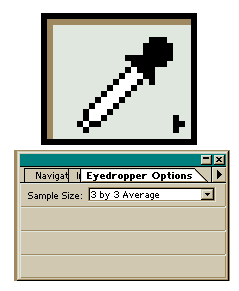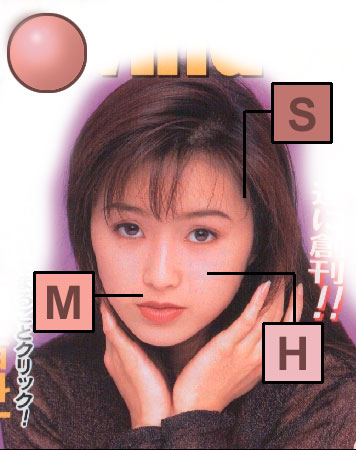I get a lot
of questions asking about "What values do I use to get decent
SkinTones". I figured,
rather than just rattling off a bunch of RGB values it would be
best to show you how to get them yourself. That way if you had
a specific person in mind you wanted the tones of (Say you really
dig Catherine Zeta Jone's olive complextion) You would know how
to aquire them. This technique is also good for capturing skintones
from different ethnicities or lighting situations.
|
 |
Step 1:
Set up your Eyedropper.
There
a little more to getting realistic skin tones than just clicking
on a photo (although not MUCH more). The default setting for the
eyedropper tool is 1X1 pixel sample. If you've ever zoomed in
on a photo you know pixel colors range all over the place..so
you want an average. Double click the eyedropper tool and the
options pallete will spring forth. Choose "3 by 3" pixel
average.
|
 |
Step 2:
Take your samples
Choose a high quality scan if you can find one...I was tired of
looking so I grabbed this one. I looked for extremes when picking
the samples...find the darkest point and the lightest point. Under
the hair or below the chin are good shadow areas. Cheeks, nose
and Forehead are good highlight areas. Find a place inbetween
to sample your midtones. I thought the space above her lips was
a good medium range.
I rendered the skin-ball in the upper left to show you how it
all works together.
|
In
case you don't feel like hunting the web for decent skintone examples:
 Save this image
to your computer and use it with the eyedropper tool in your favorite
art programs to get real skintones everytime.
Save this image
to your computer and use it with the eyedropper tool in your favorite
art programs to get real skintones everytime.
|
More Science
than Art
Why not just "eyeball" a good skintone?
Monitor calibration! Everybody's monitor sees colors differently.
Unless you spend hundreds of dollars on calibration equipment
and keep your room in total darkness...chances are your monitor's
not properly calibrated.
So what looks like skintone to you may look too pinkish or greenish
to someone else.
Over here to the left is a swatch pallette created from "Prepress
Target values for Skin" ..which means a bunch of people in
the print industry got together and came up with some set values
to help them color correct digital images before going to print.
|
|
|